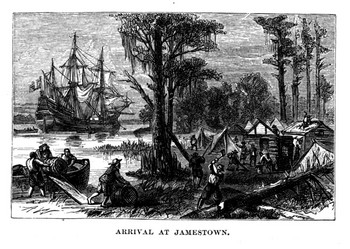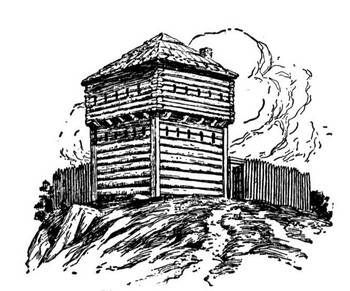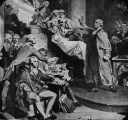Explorers had been landing in America for some time before English settlers arrived in what is now Jamestown, Virginia, in 1607. But it was in that spot on the James River that English colonization began and with it, the history of America. James I was king of England at that time, and he had granted approval for a group of businesspeople to settle in this new land. They were part of the Virginia Company, and they got the go-ahead in 1606. By December of that year, the expedition was ready. Hearing stories from Spanish explorers and others, they hoped to find gold in the New World.
The terrible winter of 1609 convinced most of the settlers to abandon their new life, however. Only 60 of the 214 settlers survived this harsh winter, which was also hard on Powhatan's tribe and other neighboring Native Americans. (It is this Powhatan, also, whose daughter Pocahontas eventually married John Rolfe.)
Once the money started flowing in regularly, the Jamestown colony grew, as did other settlements in Virginia and in other states along the eastern seaboard.
The year 1619 also saw another significant development: the first arrival of black slaves on boats from Africa. The Virginia Colony–and Jamestown, in particular–were gripped by a particularly violent series of events in 1676, known as Bacon's Rebellion. A few hundred armed colonists rebelled against the governor, who was himself backed by a few hundred armed English troops. One of the causes of the insurrection was a disagreement over land policies regarding Native Americans. Deaths, of both Englishmen and Native Americans, numbered in the dozens. Jamestown was also the capital of Virginia and remained so until 1698. |
|
Social Studies for Kids
copyright 2002–2024
David White

 In
all, 214 people set sail for America. They reached it on May
14, 1607. Very soon after they landed, the English found
themselves under attack from Algonquins, a Native American
tribe who had been living in that area for some time and who
didn't exactly welcome new settlers. The English managed to
drive off the attackers, who came back every now and then.
The English, however, were there to stay.
In
all, 214 people set sail for America. They reached it on May
14, 1607. Very soon after they landed, the English found
themselves under attack from Algonquins, a Native American
tribe who had been living in that area for some time and who
didn't exactly welcome new settlers. The English managed to
drive off the attackers, who came back every now and then.
The English, however, were there to stay. Under
the leadership of Captain
Under
the leadership of Captain  One
of the main crops grown by the English settlers was tobacco,
which they sold to Native Americans and to people back in
England, beginning in 1612. Tobacco became a very popular
crop because it was easy to grow and because it brought in
so much money. The settlers never did find gold, but they were happy to have the money that other people were paying for tobacco.
One
of the main crops grown by the English settlers was tobacco,
which they sold to Native Americans and to people back in
England, beginning in 1612. Tobacco became a very popular
crop because it was easy to grow and because it brought in
so much money. The settlers never did find gold, but they were happy to have the money that other people were paying for tobacco. America's
first elected assembly, the
America's
first elected assembly, the 
